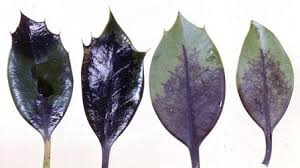Holly Twig Blight (Ilex spp.) is a fairly common disease in the Pacific coastal region of Canada and the northwestern United States.
This disease is caused by a fungus-like organism called “Phytophthora ilicis.” There are several well known pathogens in the genus Phytophthora, many of which cause root rots or trunk cankers, including the ‘Sudden Oak Death’ pathogen, P. ramorum. Phytophthora species in general require free water to complete their infection cycle, and this is an important factor in any Phytophthora disease situation.
The Symptoms of Holly Twig Blight
 Symptoms of Holly Twig Blight normally begin as small purple to black spots on the leaves, or necrotic bunches of berries. As the disease progresses, the spots develop into purple or black blotches and the infection will also move into the twigs, causing dieback, defoliation, and cankers.
Symptoms of Holly Twig Blight normally begin as small purple to black spots on the leaves, or necrotic bunches of berries. As the disease progresses, the spots develop into purple or black blotches and the infection will also move into the twigs, causing dieback, defoliation, and cankers.
The disease is favored by cool temperatures and moist weather, and often the symptoms will subside in the summer months. Inoculum persists in soil, and also is produced on the cankered areas of twigs. During wet and cool spring or fall weather, spores are produced which splash onto leaves, penetrate the tissue, and cause the initial leaf spot symptoms. Often the symptoms will be worst on the lowest leaves and branches where inoculum has splashed onto foliage.
Treatment Options
There are several simple cultural methods which can dramatically reduce the severity of this disease. Pruning plants to increase air circulation and light penetration will help to avoid wet leaves, which are essential for infection. Also, overhead irrigation that wets foliage should be avoided. If the affected holly is tree-form, the lowest branches can be pruned in order to remove the possibility of inoculum splashing up from the soil below. This pathogen does not readily penetrate bark but will infect leaves.
In addition to cultural control, there is an effective chemical control option. When applied as a soil drench, this option has proven to be effective against the fungus-like organism and will stop spread of the disease; however, it will not eradicate the pathogen from the soil.
Conditions that are conducive to disease development must be corrected before discontinuation of treatments in order to prevent this disease long term.
